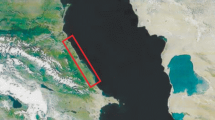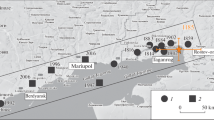Abstract
A method for determining the focal mechanisms of earthquakes using the S-wave polarization direction for weak close seismic events is developed based on the detailed seismological studies carried out by the seismological expedition of the Institute of Physics of the Earth of the Russian Academy of Sciences in 1999–2001 near the Bushehr nuclear power plant (NPP) in Southern Iran. The results of the reconstruction of such determinations are compared with the focal mechanisms of strong earthquakes determined in ISC catalogs using the standard method and with modern concepts of tectonic deformation of the earth’s crust in a wide vicinity of the region under consideration. It has been established that this reconstruction is in good agreement with both the typification of movements in the foci of strong earthquakes and modern concepts about the nature of the deformation of the earth’s crust within the observation network. This allows us to recommend this method for reconstructing focal mechanisms in other regions.








Similar content being viewed by others
REFERENCES
Adams, A., Brazier, R., Nyblade, A., Rodgers, A., and Al-Amri, A., Source parameters for moderate earthquakes in the Zagros mountains with implications for the depth extent of seismicity, Bull. Seismol. Soc. Am., 2009, vol. 99, pp. 2044–2049.
Allen, M., Jackson, J., and Walker, R., Late Cenozoic reorganization of the Arabia–Eurasia collision and the comparison of short-term and long-term deformation rates, Tectonics, 2004, vol. 23, no. 2, TC2008. doi 10.1029/2003TC001530
Allen, M.B., Saville, C., Blanc, E.J.-P., Talebian, M., and Nissen, E., Orogenic plateau growth: Expansion of the Turkish–Iranian plateau across the Zagros fold-and-thrust belt, Tectonics, 2013, vol. 32, no. 2, pp. 171–190.
Authemayou, Ch., Bellier, O., Chardon, D., Malekzade, Z., and Abassi, M., Role of Kazerun fault system in active deformation of the Zagros fold-and-thrust belt (Iran), C. R. Geosci., 2005, vol. 337, pp. 539–545.
Authemayou, Ch., Chardon, D., Bellier, O., Malekzadeh, Z., Shabanian, E., and Abbassi, M.R., Late Cenozoic partitioning of oblique plate convergence in the Zagros fold and-thrust belt (Iran), Tectonics, 2006, vol. 25, TC3002. doi 10.1029/2005TC001860
Authemayou, Ch., Bellier, O., Chardon, D., Benedetti, L., Malekzade, Z., Claude, Ch., Angeletti, B., Shabanian, E., and Abbassi, M., Quaternary slip-rates of the Kazerun and the Main Recent Faults: Active strike-slip partitioning in the Zagros fold-and-thrust belt, Geophys. J. Int., 2009, vol. 178, pp. 524–540. doi 10.1111/j.1365-246X.2009.04191.x
Bachmanov, D.M., Trifonov, V.G., Hessami, K., et al., Active faults in the Zagros and central Iran, Tectonophysics, 2004, vol. 380, nos. 3–4, pp. 221–241. doi 10.1016/j.tecto.2003.09.021
Baker, J., Llu, J.P., Robertson, E.J., and Efstratiadis, A., Role of insulin-like growth factors in embryonic and postnatal growth, Cell, 1993, vol. 75, pp. 73–82.
Berberian, M., Natural Hazards and the First Earthquake Catalogue of Iran, vol. 1: Historical Hazards in Iran prior to 1900, Tehran: IIEES, 1994.
Berberian, M., Master blind thrust faults hidden under the Zagros folds: Active basement tectonics and surface morphotectonics, Tectonophysics, 1995, vol. 241, pp. 193–224.
Berberian, M. and King, G., Towards a paleogeography and tectonic evolution of Iran, Can. J. Earth Sci., 1981, vol. 18, pp. 210–285.
Berberian, M. and Yeats, R.S., Patterns of historical earthquake rupture in the Iranian plateau, Bull. Seismol. Soc. Am., 1999, vol. 89, pp. 120–139.
DeMets, C., Gordan, R.G., Argus, D.F., and Stein, S., Current plate motions, Geophys. J. Int., 1990, vol. 101, pp. 425–478.
Falcon, N., Southern Iran: Zagros mountains, in Mesozoic-Cenozoic Orogenic Belts, 1974, vol. 4, pp. 199–211.
Ford, M., Depositional wedge tops: interaction between low basal friction external orogenic wedges and flexural foreland basins, Basin Res., 2004, vol. 16, pp. 361–375.
Hessami, Kh. and Jamali, F., Explanatory notes to the map of major active faults of Iran, J. Seismol. Earthquake Eng., 2006, vol. 8, no. 1, pp. 1–11.
Hessami, Kh., Koyi, H., and Talbot, C., The significance of strike-slip faulting in the basement of the Zagros fold and thrust belt, J. Petrol. Geol., 2001, vol. 24, pp. 5–28.
Hessami, Kh., Nilforoushani, F., and Talbot, C., Active deformation within the Zagros mountains deduced from GPS measurements, J. Geol. Soc. London, 2006, vol. 163, pp. 143–148.
Jackson, J. and McKenzie, D., Active tectonics of the Alpine–Himalayan belt between Western Turkey and Pakistan, Geophys. J. R. Astron. Soc., 1984, vol. 77, pp. 185–264.
Kreemer, C., Holt, W.E., and Haines, A.J., An integrated global model of present-day plate motions and plate boundary deformation, Geophys. J. Int., 2003, vol. 154, no. 1, pp. 8–34. https://doi.org/. doi 10.1046/j.1365-246X.2003.01917.x
McClusky, S., Reilinger, R., Mahmoud, S., Ben Sari, D., and Tealeb, A., GPS constraints on Africa (Nubia) and Arabia plate motions, Geophys. J. Int., 2003, vol. 155, no. 1, pp. 126–138. https://doi.org/. doi 10.1046/ j.1365-246X.2003.02023.x
McQuarrie, N., Crustal scale geometry of the Zagros fold-thrust belt, Iran, J. Struct. Geol., 2004, vol. 26, pp. 519–535.
McQuillan, H., The role of basement tectonics in the control of sedimentary facies, structural patterns and salt plug emplacements in the Zagros fold belt of southwest Iran, J. Southeast Asian Earth Sci., 1991, vol. 5, pp. 453–463.
Molinaro, M., Leturmy, P., Guezou, J.-C., Frizon de Lamotte, D., and Eshraghi, S., The structure and kinematics of the southeastern Zagros fold-thrust belt, Iran: From thin-skinned to thick-skinned tectonics, Tectonics, 2005, vol. 24, TC3007. doi 10.1029/2004TC001
Mouthereau, F., Timing of uplift in the Zagros belt/Iranian plateau and accommodation of late Cenozoic Arabia–Eurasia convergence, Geol. Mag., 2011, vol. 148, pp. 726–738.
Mouthereau, F., Tensi, J., Bellahsen, N., Lacombe, O., De Boisgrollier, T., and Kargar, S., Tertiary sequence of deformation in a thin-skinned/thick-skinned collision belt: The Zagros folded belt (Fars, Iran), Tectonics, 2007, vol. 26, p. TC5006. doi 10.1029/2007TC002098
Mouthereau, F., Lacombe, O., and Verges, J., Building the Zagros collision orogen: Timing, strain distribution and the dynamics of Arabia/Eurasia plate convergence, Tectonophysics, 2012, vols. 532–535, pp. 27–60. doi 10.1016/j.tecto.2012.01.022
Nissen, E., Tatar, M., Jackson, J.A., and Allen, M.B., New views on earthquake faulting in the Zagros fold-and-thrust belt of Iran, Geophys. J. Int., 2011, vol. 186, pp. 928–944.
Rebetskii Yu.L., Lukk A.A., Tatevosyan R.E., Bykova V.V. Determination of weak earthquake focal mechanisms and modern geodynamics of southern Iran, Geodin. Tektonofiz., 2017, vol. 8, no. 4, pp. 971–988. doi 10.5800/GT-2017-8-4-0327
Talbot, C.J. and Alavi, M., The past of a future syntaxis across the Zagros, Salt Tectonics, 1996, vol. 100, pp. 89–109.
Talebian, M. and Jackson, J., Offset on the Main Recent Fault of the NW Iran and implications for the late Cenozoic tectonics of the Arabia–Eurasia collision zone, Geophys. J. Int., 2002, vol. 150, pp. 422–439.
Talebian, M. and Jackson, J., A reappraisal of earthquake focal mechanisms and active shortening in the Zagros mountains of Iran, Geophys. J. Int., 2004, vol. 156, pp. 506–526.
Tatar, M., Hatzfeld, D., Martinod, J., Walpersdorf, A., Ghafori-Ashtiany, M., and Chery, J., The present-day deformation of the central Zagros from GPS measurements, Geophys. Res. Lett., 2002, vol. 29, no. 19, pp. 33-1–33-4. doi 10.1029/2002/GL015427
Tavakoli, F., Walpersdorf, A., Authemayou, C., Nankali, H.R., Hatzfeld, D., Tatar, M., Djamour, Y., Nilforoushan, F., and Cotte, N., Distribution of the right-lateral strike-slip motion from the main recent fault to the Kazerun fault system (Zagros, Iran): Evidence from present-day GPS velocities, Earth Planet. Sci. Lett., 2008, vol. 275, nos. 3–4, pp. 342–347. doi 10.1016/j.epsl.2008.08.030
Vernant, P., Nilforoushan, F., Hatzfeld, D., et al., Present-day crustal deformation and plate kinematics in middle east constrained by GPS measurements in Iran and Northern Oman, Geophys. J. Int., 2004, vol. 157, pp. 381–398.
Vita-Finzi, C., Rates of Holocene folding in the coastal Zagros near Bandar Abbas, Iran, Nature, 1979, vol. 278, pp. 632–634.
Walpersdorf, A., Hatzfeld, D., Nankali, H., Tavakoli, F., Nilforoushan, F., Tatar, M., Vernant, P., Chery, J., and Masson, F., Difference in the GPS deformation pattern of North and Central Zagros (Iran), Geophys. J. Int., 2006, vol. 167, no. 3, 1077. doi 10.1111/j.1365-246X.2006.03147.x
Yunga, S.L., On the mechanism of deformation of seismoactive amount of the Earth crust, Izv. Akad. Nauk SSSR: Fiz. Zemli, 1979, no. 10, pp. 14–23.
Yunga, S.L., Metody i rezul’taty izucheniya seismotektonicheskikh deformatsii (Methods and Results of Seismotectonic Deformation Studies), Moscow: Nauka, 1990.
ACKNOWLEDGMENTS
This work was supported by the Institute of Physics of the Earth of the Russian Academy of Sciences.
Author information
Authors and Affiliations
Corresponding authors
Additional information
Translated by O. Pismenov
Rights and permissions
About this article
Cite this article
Lukk, A.A., Rebetsky, Y.L. Modern Geodynamics and Focal Mechanisms of Earthquakes near the Bushehr Nuclear Power Plant. Izv. Atmos. Ocean. Phys. 54, 1477–1489 (2018). https://doi.org/10.1134/S0001433818100055
Published:
Issue Date:
DOI: https://doi.org/10.1134/S0001433818100055




